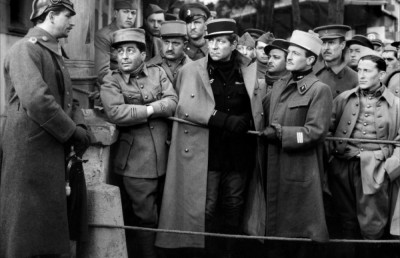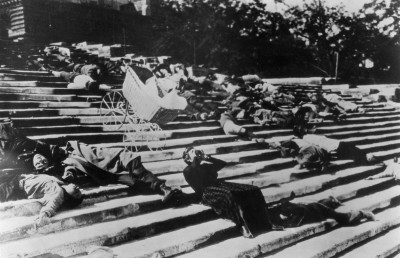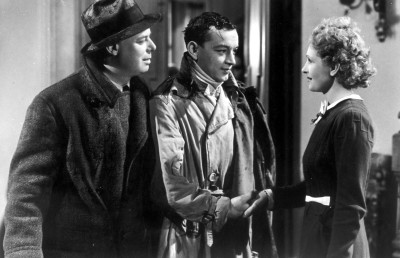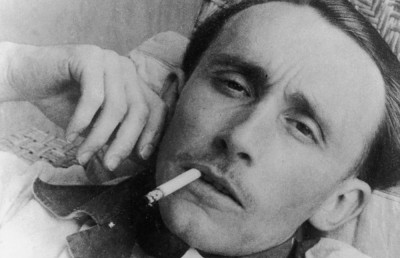The Little Engine that Could: an interview with caboose master Timothy Barnard
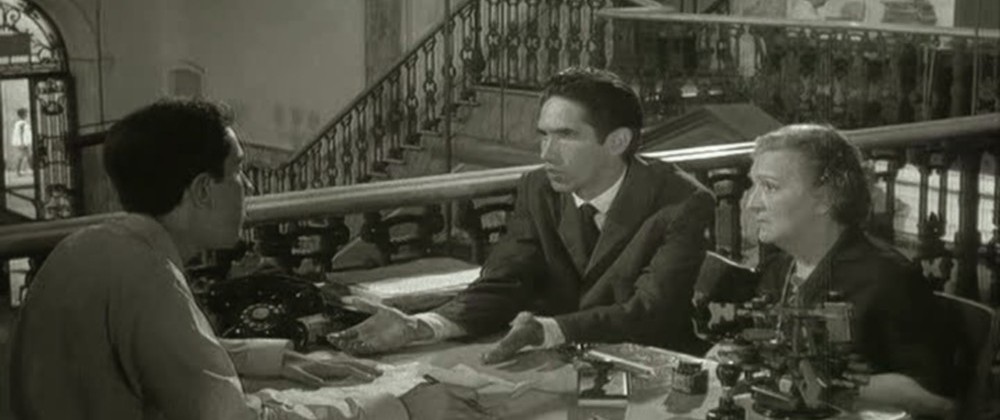
Offscreen: We should probably start at the beginning by having you tell us a little bit about yourself, your background, and how you came to the publishing business, in general (previous books, etc.).
Timothy Barnard: My background is film studies, starting with a B.A. in Montreal many years ago and an M.A. at the University of Iowa in the late 1990s after a prolonged absence from school. Just as important were the millions of films seen at cinémathèques in cities where I’ve spent time: Montreal, Paris, Buenos Aires, Havana. Between my B.A. and M.A. degrees I did my own archival research and writing and editing, mostly on Latin American cinema at the time. In the past ten years my work has focused on early cinema, French cinema between the wars and the films of Jean-Marie Straub and Danièle Huillet. I became a publisher because I don’t have time (we’ll leave aside for the moment the question of expertise) to write all the books I want to read. It is caboose’s immodest goal to change the course of English-language film studies (which has surely gone astray)—publishing not just as a means of disseminating work already being done but the publisher as a catalyst for a new approach to the field.
Offscreen: Why ‘caboose’?
Timothy Barnard: My first choice, ‘The Little Engine that Could’, didn’t seem very practical.
Offscreen: Do you have any formal training in translation?
Timothy Barnard: At the risk of confirming people’s worst fears: none whatsoever. I hasten to add, however, that I have spent the past 8 years running my own translation business in Montreal and have translated some two million words during that time (the equivalent of about 20 books). I have been involved in some interesting and challenging translation projects, particularly modern art catalogues. Last year I translated a catalogue for the Montreal Museum of Fine Arts (my third or fourth for them) on Cuban art, mostly from Spanish but also from French. I also contributed an essay on Cuban film. This volume was named by Booklist one of the ten-best art books published in North America in 2008. I also translate for the two other major art museums in Quebec, a number of smaller art galleries, the National Film Board of Canada, various European clients and several professors. Without all this experience, translating André Bazin would have been unthinkable.
Offscreen: What were some of the greatest challenges in translating this book, from a strict translating perspective?
Timothy Barnard: Translating Bazin was much trickier than I thought it would be when I set out. His writing seems straightforward enough, and indeed I think he prided himself on being accessible, writing in both literary and intellectual journals for people who often had little real knowledge of film and in publications with a less intellectual approach. The essay on Charlie Chaplin was written for a post-war popular education magazine called DOC, and we know he loved to speak to regular people about film at ciné-club and even factory screenings.
And yet when he begins to veer off into a more abstract mode he can become very difficult to pin down. The essay on Robert Bresson was incredibly hard to translate. My copy-editor was fine with everything until he hit that piece, which he wanted to start tearing apart and re-writing. I can’t really give examples of where and how, it just has a degree of abstraction that was very hard to grasp. In the end I think that this article could have been his greatest achievement but that he didn’t quite pull it off. (Or it may simply not be translated well . . .) He no doubt wasn’t able to give each piece the amount of time his ideas required. Certainly Bresson was the major filmmaker of his day, and this essay really defined the issues at play in his work at the time. And, as I like to remark to students when I teach Bazin, this is film theory that is at one and the same time intellectually challenging, fairly easy to read and the product of a direct engagement with the films themselves, a combination very few film theorists have been able (or tried) to replicate since.
One of the things about Bazin’s writing, finally, is that you can really see his thought process at work. He jumps around a fair bit and leaves some things unstated. You are usually pretty sure what he is thinking and what he left out to connect his thoughts—sometimes this is as simple as making sure the reader knows which of the films he has up in the air he is referring to at any precise moment—but as a translator you have to avoid filling in too many blanks for fear of making a mistake or inflecting the work in a way that wasn’t intended.
Offscreen: How did the idea of a new translation of Bazin come about? Was it a question of being unsatisfied with the existing translation by Hugh Gray? Or the fact that several key essays were left out by Gray from the French book Qu’est-ce que le cinéma?
Timothy Barnard: The seed was unwittingly planted by Dudley Andrew, who as you know is the leading Bazin scholar in any language, when we were both at Iowa (he has since moved to Yale). During the brief time I was there Dudley was involved in a project to publish a multi-volume complete works of his writings in English, but the whole thing fell through.
Like everyone else, I had read Bazin as an undergraduate. I have to confess that I wasn’t particularly struck by it—I was very young and my interests in film at the time were quite far removed. But, years later, being around Dudley prompted me to take a second look at the material, this time also with an eye more closely attuned to issues of translation—a professional malady that is something of a mixed blessing—and I saw more clearly both the immense richness of the writing and the terrible poverty of most of the existing translations.
I hope Dudley will forgive me when I say how glad I am that his project never got off the ground, giving me the opportunity to take it on. As for my not fully recognising Bazin’s worth when I read him at the age of 20, we could chalk this up to immaturity, and I’m sure we would not be far off the mark, but I would be thrilled if I were to hear from anyone who teaches Bazin regularly that my translation has made their task easier and raised their students’ level of interest. Certainly the existing translation of What is Cinema? is murky enough to turn people off it.
Offscreen: I know something of it has to do with the copyright laws. Can you talk about that, and whether there are any differences between the copyright law in Canada and the US? If so, how will this impact on the marketing of the new translation?
Simply and briefly put, Canada has a copyright law which puts books and other cultural products into the public domain, meaning that anyone can publish them without seeking permission from the author, sooner than in the United States and Europe. These countries used to subscribe to the same term as Canada, but corporate lobbying in the U.S., and then trade pressure by the U.S. on Europe and countries such as Australia, South Korea, Argentina, and Chile have extended terms of copyright to sometimes ridiculous lengths. Canada’s law, which until relatively recently was the norm worldwide, strikes a fair balance between readers’ and authors’ rights—after a certain period of time it is not the long-deceased author or his or her family who is benefiting from extended copyright terms, it is the large corporations to which they signed away their rights in their lifetimes.
In practical terms, this means that caboose’s edition of What is Cinema? can only be sold in Canada, Japan, China, New Zealand, and a number of smaller countries.
Offscreen: Why do you think the time is right for this new translation (outside of the fact that it is now possible)? In other words, what is your view on the relevancy of André Bazin in today’s academic and scholarly landscape?
Timothy Barnard: I could give you some stock answer about the perennial relevance of questions of ‘the ontology of the image in the digital age’, but let me answer that question with a couple of personal anecdotes concerning fields of study we might not normally associate with Bazin.
A few years ago I was teaching a course on Cuban cinema, and discussing with my students both Cuban cinema’s penchant for humour and its use of ‘Brechtian’ reflexive techniques, particularly in its heyday in the 1960s. One day, after watching Tomás Gutiérrez Alea’s Death of a Bureaucrat together, my best student put up her hand—this I think was the first undergraduate film course I had taught, and I was amazed at how brilliant some of these nineteen-year-olds were—and said that she got the reflexive stuff (!) but wondered what the connection was with Cuban humour. ‘Why reflexive comedy?’ she asked. I was stumped. Later, reading Bazin, I came upon what I think is a partial answer: audience laughter, Bazin wrote—and Cubans certainly laugh out loud at the movies, another research topic of mine—makes people aware of themselves. What’s more, he said this in what I would call his ‘Brechtian essay’, ‘Theatre and Film’ part two, where he discusses cinema’s tendency to create identification between viewer and film and theatre’s tendency to create what I translate as ‘dissociation’ between viewer and play—and he makes the specific claim that film comedy can mitigate film’s inherent movement towards identification and help create a sense of dissociation.
Now, Bazin surely never saw a Cuban film in his life, and in any event he died before the revolutionary period that produced such work. He also apparently never read Brecht. And yet, and in this he is like the great canonical philosophers, whose ideas are relevant after vast stretches of time and to the most diverse situations, I think we have here both the basis for an answer to my student’s question and a hint of a Brechtian side to Bazin, which I explore superficially in a footnote and hope others will take up more rigorously. All in all, this is why caboose’s publicity for the book states that no matter what your field of specialisation in today’s highly-fragmented world of film and media studies, there is something in Bazin for you! And discovering that something is half the fun.
Allow me to prolong this for a moment more with my second anecdote. Seemingly light years away from Cuban comedy we find the films of Jean-Marie Straub and Danièle Huillet, which I have been following closely since the early 1980s. I should say first of all that I have always seen Straub and Huillet as French Nouvelle vague filmmakers, not the German New Cinema filmmakers they are usually taken for, particularly in North America, where people’s familiarity with their films sometimes begins and ends with The Chronicle of Anna Magdalena Bach from 1968. Straub in particular was present throughout the 1950s in France, the biggest influence on him was Bresson, and he even mutters somewhere that he submitted a text to Cahiers du Cinéma but that Bazin rejected it. I’d love to get my hands on that! But then he and later Huillet left the country right on the eve of the Nouvelle vague explosion because of the military draft and the war in Algeria and they began their filmmaking career in Germany (Straub is from Alsace and grew up during the war speaking German).
The films by Straub and Huillet that fewer people are familiar with, beginning with Othon in 1969 and stretching through to The Death of Empedocles in 1986 and Antigone in 1992 in particular (there are many others), have a particular relevance to Bazin’s theories of literary and theatrical adaptations in the cinema. Reading these chapters in What is Cinema? my reaction was one I usually try to avoid, that of thinking that there is a ‘perfect fit’ between these films and Bazin’s theories. Straub and Huillet’s work consists almost invariably of transposing an existing text from its original medium to film without trying to ‘adapt’ it in the way Bazin laments in his essays. They really do carry the text and all its aesthetic baggage kicking and screaming into the cinema in a way we know to have been inspired by Straub’s encounter as a young man with the Bresson of Diary of a Country Priest and Les Dames du Bois de Boulogne, films Bazin discusses at length with respect to his own theory of adaptation. Straub and Huillet’s films, and it pains the critic in me who tries to avoid simplistic readings to say this, appear in this light like a lifelong exercise in Bazin’s theory of adaptation—to the point that I am working up the courage to write Straub and ask him about his reading of Bazin. People speculate about what Bazin would have thought of the 1960s films of Truffaut and Godard, having died just as their filmmaking careers got underway, but I dream about him watching Straub-Huillet films from the 1980s and 90s in heaven and seeing the perfect realisation of his theory of literary adaptation, which he foresaw but, apart from Bresson, never really got to see in practice.
Offscreen: Having immersed yourself in Bazin, is there any single writing or idea that surprised you? I always find him so alarmingly fresh when I re-read him. Do you get the same sensation?
Timothy Barnard: Not a single idea that I can think of. On the contrary, what’s wonderful and surprising about reading Bazin is the accumulation of ideas—encountering stimulating thought after stimulating thought in the course of a few brief pages. He packs more into one short essay than any of us could pack into several books.
Offscreen: How did you go about deciding which Bazin essays not included by Gray to include in your translation? Are there any essays left out that you regret not including in this volume? (Or, which essay did you most regret leaving out?) How did you decide on what the length limit of your book would be? Since there any still many essays Gray left out and that have not been translated, are you considering a second volume?
Timothy Barnard: From the start the idea of this volume was simply to provide new translations of what are seen as the key essays in Bazin’s What is Cinema? collection. The choice of texts took no more than an hour at the very beginning, and there have been no regrets or second-guessing since, at least on my part. The caboose edition is intended to function as a kind of ‘Bazin Reader’ for undergraduates and film buffs who want an introduction to his main ideas through some of his better-known essays. At the same time, I hope, it will provide a corrective to specialists, because none of us, reading the existing translations, can say we know Bazin. For someone whose own research has always focused on the more obscure nooks and crannies of film history and theory, this may not appear to have been an obvious choice, but one has to start somewhere. The point is that these texts are canonical, and sometimes the canon exists for a good reason. There is no point in delving into so-called ‘minor’ Bazin texts if you aren’t familiar with the ‘major’ ones, and given the crying need for new translations of these essays this was obviously the place to start. Translation, and publishing in general, is also extremely time consuming, so there was no question of simply starting off with a multi-volume set. For now, anyone doing serious research into Bazin obviously has to work with the French.
Now, this still allows for a certain flexibility and unorthodoxy in determining what is ‘major’. I think the text fragment on Jean Painlevé is essential, and yet not only has it never been translated into English but Bazin’s French publisher has dropped it from its abridged edition of Qu’est-ce que le cinéma? You have to find an original edition from 1958 to read it in the French. With the upcoming release of a compilation of Painlevé films on DVD, I hope this text will set the stage for this director’s discovery by English-language critics. The text on Jacques Tati and ‘Monsieur Hulot’ is also very important, but was only translated once many years ago and is long out of print.
As for future projects exploring Bazin’s writings in greater depth, caboose does indeed have other translations in the works, but these will have to remain a secret for the time being. To be continued!
Offscreen: In terms of the essays for which you reverted to the original rather than the ones which appeared in Qu’est-ce que le cinéma?, what made you decide on these five?
Timothy Barnard: This too was a decision that was easier to arrive at than might first appear. The five essays you refer to are the last five in the volume and are drawn from volumes two and four of Bazin’s original four-volume set. The first eight essays all come from the first volume of the set. Of these eight essays, none really lent itself to being translated in an original version. Either the version published in the anthology already was the original version, for all intents and purposes (this is the case with the Tati and Wyler essays) or they were modified so drastically for re-publication by Bazin that they would have been unrecognisable in their ‘original’ form. Here we would be talking not just about a variant but about a completely different text, or texts, as some of these initial eight essays are composites of earlier texts.
The final five essays are different in that Bazin re-published them largely in their original form but snipped things out here and there—offhand I would venture from memory that he always cut and never added, except a few footnotes. The possibility of translating the original thus presented itself more clearly and feasibly; it was simply a matter of adding back a few lines here and there. When I looked at what he cut, I was intrigued and thought the material worthy of notice. In most cases it is just a few lines or a paragraph; only in the ‘Impure Cinema’ essay did he cut two or three pages of text, most likely because he realised that he made similar arguments in another essay he was including in the anthology. But I think the material I have put back is of value.
Others may question this apparent flaunting of the author’s wishes, even of his last wishes we might say, because he was working on the revisions for What is Cinema? when he died, but we should remember that the four pieces on literary and theatrical adaptations from volume two were further revised after his death, by Truffaut apparently. Thus if some versions of these articles are more ‘authentic’ than others, they are the originals and not the versions published posthumously with which we are familiar. (In the case of the fifth of these articles, on Italian neo-realism from the fourth volume of the set, Jacques Rivette was responsible for getting it to press and states in his preface that he did not alter it in any way.)
Offscreen: From having read your translation, I did notice some dramatic changes from previous translations. Is there a single essay which you feel most benefited from your new translation (in other words, which essay has gained the most from your translation)?
Timothy Barnard: Let me say first of all, on the radical differences between my translation and previous translations, that, except in the case of out-and-out mistakes on my part, which I hope and believe to be few in number, everything in my translation is in Bazin. First of all, nothing has been made up to make the translation make sense—this usually means the translator didn’t understand the text. Second, every word, every adjective, is an accepted rendering of the French word. In translation you have to go beyond the first word that pops into your head, and in many cases beyond the cognate, to arrive at a worthwhile version of the text. Previous translators of these essays were simply unaware of this basic rule.
The one essay I would say has most benefited from my translation, if I may, is ‘The Evolution of Film Language’. This is a major theoretical statement by Bazin, one of the few essays in the collection that doesn’t focus on a filmmaker or body of films or a specific theme like literary adaptation. It really sets out his philosophy of film history and aesthetics.
The problem with the existing translation of this essay is that it translates the one key term in it, découpage, as ‘editing’, thereby skewing the entire meaning of the essay. I won’t go into découpage here (readers can find my footnote on this topic in PDF form on the caboose web site), [I also go into it extensively in my review essay, ed.] except to say that it is everything but editing: it is the filmmaker’s visualisation of the film before and during the shooting. Basically, it is where to place the camera and when and where and how to move it. The concept is fundamental to Bazin’s theory of cinema but appears nowhere in previous translations of essays from What is Cinema?, although naturally someone like Jonathan Rosenbaum knew to retain it in his translation of Bazin’s essays on Orson Welles.
Let me tell you a shaggy dog story about this term and this essay. It was my self-appointed task to track down all of Bazin’s sources and read every version of the articles I was translating. I also quickly learned that Bazin himself was a little hazy on the dates of his previously published work, and I wanted to correct this. For the Evolution essay he noted in his own volume simply that it was a composite of three earlier essays (in fact there were really only two; the third recapitulated these two). One of them, whose title he did not give, was originally published in 1952 in an anniversary volume for the Venice film festival.
I looked everywhere for this book. The French edition exists in no North American library; one library has the Italian edition, a language I read, but I needed to see the French. At the last minute and thinking I was simply documenting a routine bibliographical reference, I reluctantly (knowing how busy he is) asked Dudley Andrew if he could make me a copy out of his vast Bazin archive. His reply surprised me: he didn’t have it, had never seen it, and didn’t even know the title of it.
I had let this slide and it was now January, just weeks away from when the book would be typeset and printed. A couple of days later I read by chance in a Montreal newspaper that a bazaar of film memorabilia was being held in a church basement across town the next day, a Saturday. I can’t resist such things, and despite the -30 degree temperature and being almost certain the event would be a dud, I showed up an hour before it closed. The one person selling second-hand books assured me that they had been thoroughly picked over since ten o’clock that morning.
And there it was: the elusive book in which Bazin’s essay was published, a 700-page brick it turns out. It was a library discard and cost me $1. I raced home, opened it up, and almost fainted. The essay on which the ‘Evolution’ article is based, and for which I had already written a note arguing that it saw découpage and not editing as the future of film art, was entitled simply ‘Découpage’. My argument was now irrefutable. Without warning, I photocopied the article and mailed it to Dudley. He says his jaw dropped when he opened the envelope.
There’s more: in mulling the whole thing over I was struck by the date this article was published—July 1952—and the date of one of Jean-Luc Godard’s first pieces of writing on film—September 1952 in Cahiers du Cinéma_—which is entitled ‘Défense et illustration du découpage classique’, which some but not all commentators mistakenly read as a defence of editing and not découpage. Not only had no one ever read the Bazin article in this form and not only do some people misconstrue Godard’s article as a discussion of editing, but no one had realised that Godard was replying to Bazin and refuting his claims—the same claims essentially as those found in the ‘Evolution’ essay in the caboose edition of _What is Cinema? I love this sort of intellectual history and detective work, and in this case it really paid off, in the most serendipitous manner imaginable.
Offscreen: Where and how will people be able to purchase your book?
Timothy Barnard: For the time being, the book can be purchased in Canada at Pages bookstore in Toronto or on-line from its web site. Canadian trade and textbook orders should be addressed to caboose via our web site. International sales, to the countries mentioned above, are being handled by caboose until such time as we find distributors there. In order to keep the book a secret right up until its release, we decided to look for Canadian and international distributors after the book was launched. We’re happy to support Pages, a Toronto institution which will provide people with excellent service. The proprietor has been a friend of mine for 25 years. We see this as a long-term project, with solid individual and textbooks sales for years to come, and not as a book everyone will have forgotten about in six months’ time.
Offscreen: Do you have any other books that you/caboose are working on?
Timothy Barnard: My next task for caboose is to translate a series of lectures given by Jean-Luc Godard in Montreal in 1978 as a dry run for his later video essay Histoire(s) du cinéma. It’s fascinating material, the most extended and revealing glimpse of the man and his ideas we have. The sole videotapes of these talks have been slumbering in the Concordia University archives all this time. It was published in a poorly-transcribed French edition in the early 1980s, which is now long out of print. I have re-done the French transcription from start to finish, finding all sorts of things that were left out of or mangled in the French edition, and hope to provide an introductory chapter on ‘Godard in Quebec’. He said that this was the ideal place for these lectures: it allowed him to speak French and yet he was far enough from home that he was able to unburden himself in a way that he wouldn’t have in France or Switzerland. It is a truly remarkable document and fun to read. It will appeal to the new generation of DVD cinephiles and serious film scholars alike.
caboose itself has about 20 books in preparation at the moment in four thematic series of volumes. These are described in more detail on our web site, but I can tell you that they range from a reference series, Critical Filmographies of World Cinema, to an innovative essay series by leading scholars called Kino-Agora. In between there are writings by filmmakers—Godard, Pasolini, Germaine Dulac—in a series called Theory and Practice and the series Reading with Filmmakers about filmmakers as readers and how their reading influenced their work.
People will have to be patient: all this will take time to prepare. Our goal is not to produce quickie, disposable books that no one remembers a few short months later and end up getting shredded. caboose authors and editors are going the extra mile to produce work of truly lasting value. The Bazin book is something of a pre-launch; while we continue to market it, we’re going to temporarily disappear from view a little until about 2011 or 2012 when the first of these other volumes will appear.
Thank you, Donato, for this opportunity to discuss Bazin and caboose, and my thanks also to your readers for taking the time to read this and to all those who support the press.
Offscreen: You’re very welcome.
To read more on the new translation visit the excellent blog, girish and follow the André Bazin & caboose thread.



